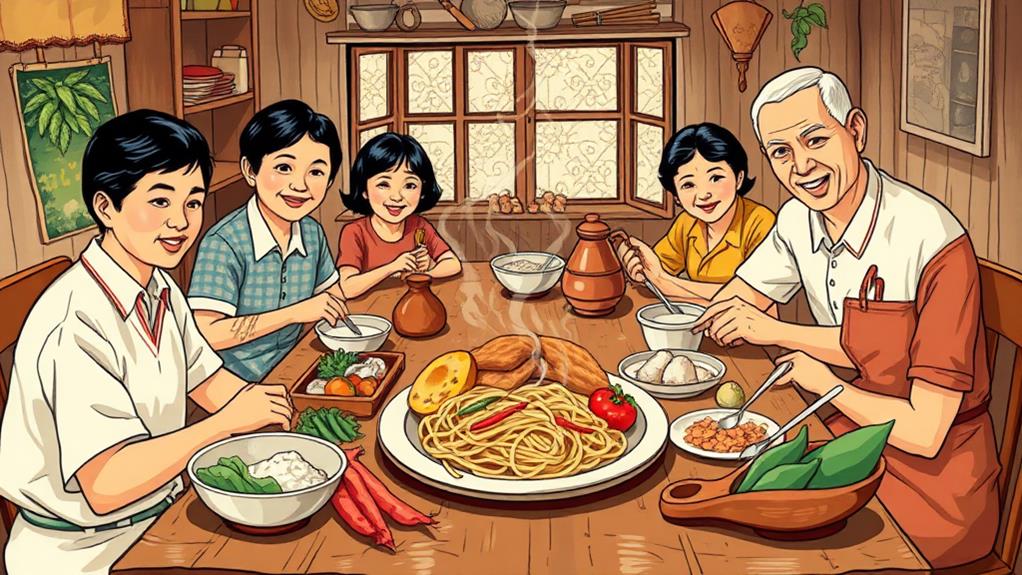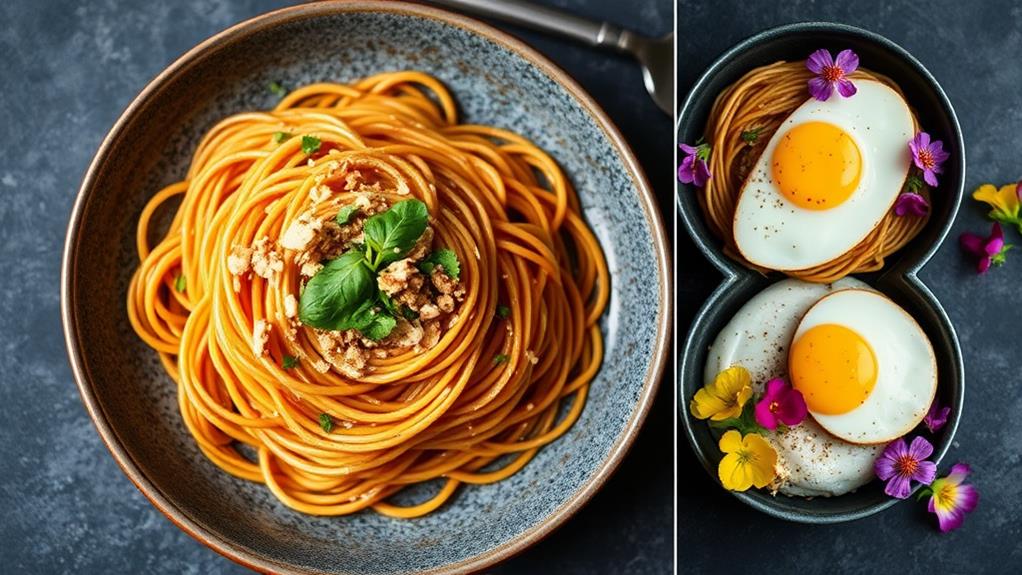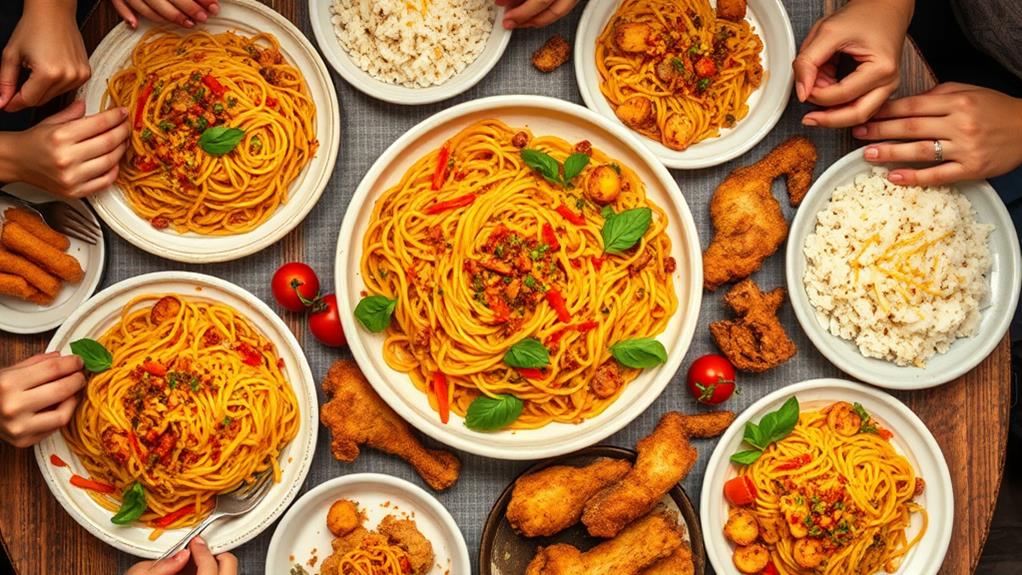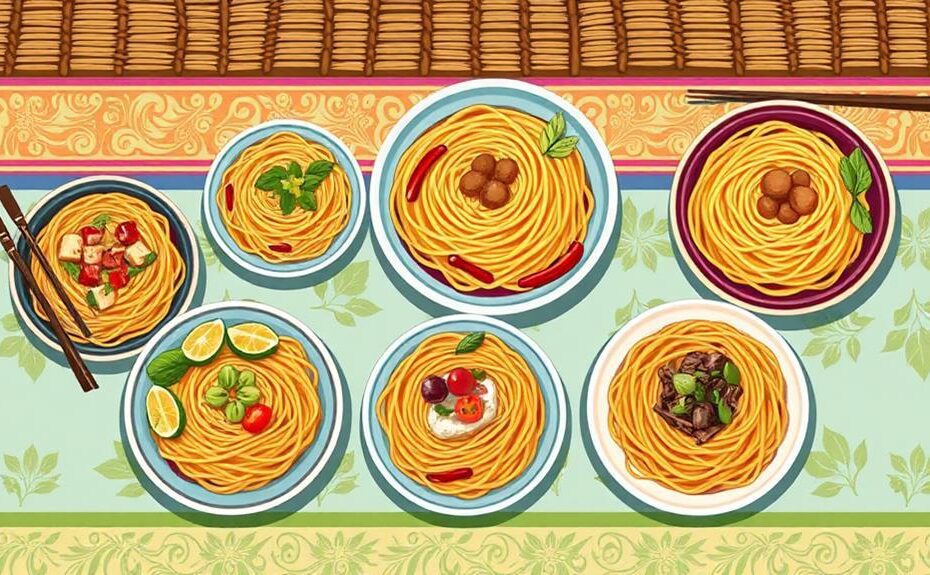Filipino spaghetti variations incorporate local ingredients and flavors. These variations often feature local meats like longganisa or Spam, adding unique textures and flavors to the traditional dish.
Sliced smoked longganisa, for example, enhances the savory flavor profile. Other recipes incorporate vegetables like bell peppers and carrots to increase nutritional value.
Regional adaptations showcase local tastes. In Nueva Ecija, for instance, bangus spaghetti is a popular variation that highlights regional flavors.
Creamier sauces can be achieved by using evaporated milk, while thicker pasta shapes improve sauce adherence. As you explore further, you'll discover even more creative twists on this beloved dish.
Filipino Spaghetti Origins and History

Filipino spaghetti is believed to have originated between the 1940s and 1960s, during the American Commonwealth Period.
During this time, Italian-style pasta dishes were introduced to the Philippines, influencing the development of Filipino spaghetti.
The dish was shaped by the scarcity of tomatoes during World War II, which led to the use of banana ketchup as a sweetener. This unique ingredient appeals to the Filipino palate and is a distinctive feature of Filipino spaghetti.
The adaptation of spaghetti to Filipino tastes involved the addition of ground meat, sliced hot dogs, and a generous topping of cheese. These ingredients reflect a fusion of culinary traditions, incorporating local flavors and ingredients.
Today, Filipino spaghetti has become a staple at family gatherings and children's birthday parties, symbolizing comfort food and cultural identity within the Philippines.
Unique Ingredients and Flavor Profiles
Filipino spaghetti boasts a distinct flavor profile that sets it apart from traditional Italian spaghetti. This unique flavor profile is achieved by combining sweet and tangy ingredients, such as banana ketchup and sugar, which balance each other out.
The savory flavor of Filipino hot dogs adds a salty contrast and a pop of color to the dish. These hot dogs are typically bright red and introduce a distinct flavor to the sauce.
Local meats like longganisa or Spam may also be used, providing different textures and flavors to the sauce.
Vegetables like bell peppers or carrots are sometimes added to the sauce, not only providing nutrients but also counterbalancing the sweetness of the banana ketchup and sugar.
Shredded cheddar cheese is often sprinkled on top, melting into the sauce and adding a rich, creamy element to the final presentation.
The combination of these unique ingredients results in a harmonious blend of flavors and textures that sets Filipino spaghetti apart from its traditional counterpart.
Upgraded Recipe Techniques and Variations

Upgraded Techniques Elevate Filipino Spaghetti
Filipino spaghetti recipes can be taken to new heights with various upgraded techniques and variations. Adding sliced smoked longganisa to the spaghetti sauce enhances the dish's savory profile and adds a unique flavor twist. This is because the smokiness of the longganisa complements the sweetness of the tomato sauce.
Incorporating vegetables like bell peppers and carrots provides additional nutrition while maintaining the dish's signature sweetness. These vegetables not only add nutrients but also texture and flavor to the dish.
Using crushed canned tomatoes instead of processed sauces results in a more robust texture and flavor. This is because crushed canned tomatoes retain more of their natural flavor and texture, making the sauce more rich and tangy.
Thicker, wider pasta shapes like tagliatelle or pappardelle allow for better sauce adherence and a more satisfying bite. These pasta shapes have a larger surface area, allowing the sauce to cling to them better and providing a more filling bite.
Adding evaporated milk to the sauce gives it a creamy texture similar to a bolognese sauce. This is because the milk adds a richness and creaminess to the sauce, making it more indulgent and flavorful.
Experimenting with ground beef adds heartiness to the dish. Ground beef provides a meatier, more filling option for those who want a more substantial meal.
Regional Differences and Adaptations
Regional variations of Filipino spaghetti reflect local tastes and ingredient availability. In Nueva Ecija, bangus spaghetti is a unique variation that incorporates local milkfish, adding a seafood twist to the traditional recipe.
Other regional variations include additional vegetables like bell peppers and carrots, which boost nutrition and texture.
The use of different meats in the sauce reflects regional preferences and local ingredient availability. For instance, longganisa or Spam may be used in the sauce, catering to local taste buds.
Even fast food chains like Jollibee have adapted their own sweet spaghetti recipes, often with a more pronounced sweetness or special sauces.
These adaptations showcase the creativity and diversity of local Filipino cuisine, resulting in a delightful array of sweet spaghetti variations.
Serving Suggestions and Cultural Significance

Filipino Spaghetti: A Cultural Icon
Filipino spaghetti is a staple at children's birthday parties, where its sweet flavor profile and vibrant presentation create a festive atmosphere that kids love.
This dish is often paired with fried chicken, which creates a balanced meal that highlights the comforting aspects of Filipino cuisine.
The Unique Sweetness of Filipino Spaghetti
Filipino spaghetti gets its unique sweetness from banana ketchup, which adds to its appeal.
The dish is also visually appealing, thanks to the bright red hot dogs that make it culturally distinctive.
Enhancing the Flavor and Texture
Serving Filipino spaghetti with grated cheddar cheese on top enhances its richness and adds a creamy texture.
Cultural Significance of Filipino Spaghetti
Filipino spaghetti represents a fusion of culinary traditions, reflecting the resilience and adaptability of Filipino culture.
Nutrition Information and Leftover Storage
Nutrition Information
A typical serving of Filipino spaghetti contains approximately 529 calories, making it a filling dish that can satisfy your hunger.
This meal option provides 63g of carbohydrates and 23g of protein, making it a nutritious choice. However, it's high in sodium, with 1068mg per serving, so those watching their salt intake should adjust their portion size accordingly.
Leftover Storage
To maintain the texture and flavor of Filipino spaghetti, proper leftover storage is essential.
Divide the meat sauce and noodles into separate airtight containers to prevent mushiness. Refrigerated leftovers can last up to 3 days, while freezing extends their shelf life to about 2 months.
To reheat frozen spaghetti, submerge it in boiling water or heat the sauce and mix with noodles until warm.
What Are Some Popular Variations of Filipino Style Spaghetti?
Some popular variations of Filipino style spaghetti uniqueness include using banana ketchup for a sweet and tangy flavor, adding hotdogs or ground pork for protein, and topping it off with grated cheese for a creamy touch. The combination of these elements creates a distinct and delicious twist on the traditional spaghetti dish.
Creative Twists and Community Engagement

Customization is essential when it comes to Filipino spaghetti, allowing you to put your own spin on this classic dish.
Experimenting with different proteins, vegetables, and toppings enables you to create unique flavor profiles that cater to your regional preferences.
Adding unique ingredients can elevate your Filipino spaghetti. For example, smoked longganisa adds a savory twist, while sautéed mushrooms provide a vegetarian option.
You can also incorporate vegetables like bell peppers and carrots for added nutrition and texture.
Serving Filipino spaghetti at parties can be more engaging with creative twists. For instance, using different shaped pastas or adding toppings like crispy bacon bits can make your dish stand out.
Sharing your creative adaptations on social media is an excellent way to showcase your unique take on Filipino spaghetti and enhance community engagement within culinary circles.
Developing your own secret family recipe is a great way to foster a sense of tradition and pride in your unique spaghetti variations.
Including special spices or additional sauces can make your recipe truly unique.
Frequently Asked Questions
What Is Filipino Spaghetti Called?
Filipino spaghetti is commonly referred to as "spaghetti Pinoy" or "Filipino spaghetti".
This name reflects the dish's distinct Filipino twist, characterized by the use of banana ketchup and sugar to create a sweet sauce that differs significantly from traditional Italian spaghetti.
The name "spaghetti Pinoy" acknowledges the cultural influences that have shaped this beloved dish, which has become a staple in Filipino celebrations and gatherings.
What Is the Difference Between Filipino Spaghetti and American Spaghetti?
Flavor Profiles Differ
Filipino spaghetti and American spaghetti have distinct flavor profiles.
Filipino spaghetti is sweet and savory, resulting from the use of banana ketchup and sugar, whereas American spaghetti is more savory and tangy.
Cultural Influences Shape Tradition
Cultural influences have shaped the role of spaghetti in each culture.
In the Philippines, spaghetti is often served at birthday parties and gatherings, whereas in America, it's a casual dining staple.
Cooking Techniques Vary
The cooking techniques used for Filipino spaghetti and American spaghetti differ.
Filipino spaghetti is simmered for a longer time to enhance flavors and tenderness, whereas American spaghetti cooking times vary depending on the recipe.
Why Is Filipino Spaghetti so Good?
Filipino spaghetti stands out due to its unique sweet sauce. This signature element is infused with banana ketchup and sugar, creating a flavor profile that's both familiar and exciting.
The sweet and savory combination makes it a staple at festive occasions.
As a comfort food, Filipino spaghetti evokes a sense of warmth and nostalgia. The dish achieves this through a delicate balance of sweet, savory, and creamy elements.
The banana ketchup adds a sweet and fruity flavor, while the sugar enhances the overall sweetness. The creamy element comes from the melted cheese and the savory flavor from the ground meat. This perfect blend of flavors makes it a dish that's hard to resist.
Filipino spaghetti's popularity stems from its ability to evoke a sense of comfort and nostalgia. It's a beloved favorite among Filipinos due to its unique flavor profile and the emotions it evokes.
Once you try it, you'll understand why it's a staple in Filipino cuisine.
What Kind of Spaghetti Does Jollibee Have?
Jollibee's spaghetti features a signature sweet sauce made with banana ketchup. This unique sauce is a key component of their spaghetti dish.
The sauce is generously topped with shredded cheddar cheese that melts into the sauce, adding a creamy element to the dish.
Slices of bright red Filipino-style hot dogs are added to the spaghetti, providing a savory contrast to the sweetness of the sauce.
This combination of flavors and textures results in a flavorful and satisfying meal.
